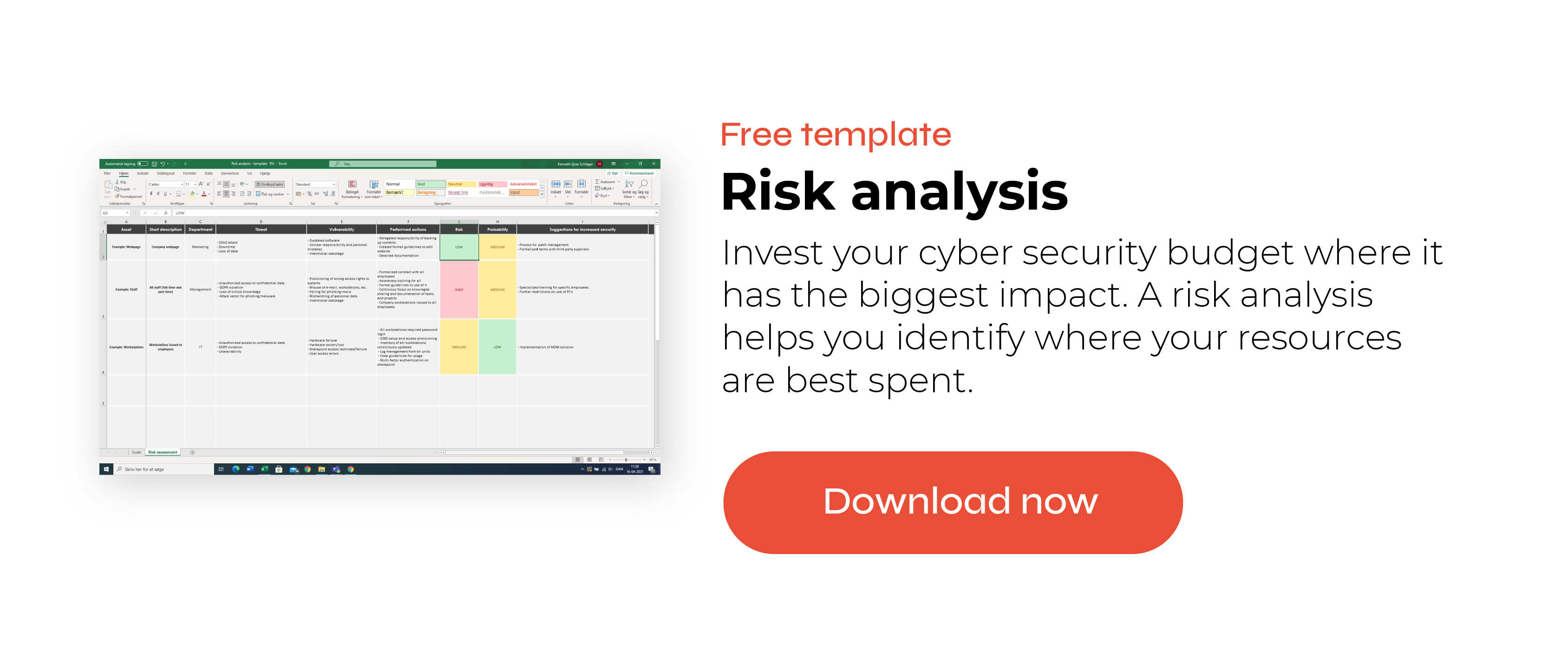In this blog post, we will unfold a challenge many organisations are faced with today: the collection and storing of log files. We will explain why it is a necessity and how your organisation can accomplish this with the introduction of log management and SIEM. You will learn what the systems can do and how they can help your organisation retain a better overview of your IT systems.
Your organisation may have had a security breach, even without you knowing
Companies may find it difficult to assess whether they have lost data or been exposed to security incidents because they do not know where to look. Firewalls, anti-virus software, and backup procedures are good measures, but experience tells us that it is not enough.
If a security breach happens in your organisation, you hardly have any opportunities to detect and respond to it. The incidents can either be due to external parties entering the company’s systems or inappropriate behaviour from within the company.
Your servers don’t log everything
The reason for this uncertainty is because most organisations do not have control over how they collect and store their log files. One common misconception we have heard from many organisations is that they believe that their servers log everything, so they can just go back and look at its logs if necessary. This, however, is not the case. Some organisations may even think that since they’ve never had any problems, they don’t need any of these insights.
Minimise the risk of a breach
There are constantly new ways that someone or something can access your data outside all your security perimeters. Therefore, the vulnerabilities/methods used to compromise data must be investigated on an ongoing basis, so that you know exactly which indicators to look for and be alerted to.
The analysis of logs with a focus on security will give any organisation a lot in terms of security, awareness, and understanding of the network. But we need to realise that it requires time and maintenance. There needs to be a lot of input from specialists – both technical and non-technical for implementation. Therefore, I would suggest getting help from experts for the project.

Apply log management to get a map of communication
In the context of IT, a log file is an automatically created and timestamped documentation of events that happen in a system, application, or asset (e.g., server). Almost every IT system produces log files.
Log files are valuable for organisations because they create a documented trail of actions, and behaviour in a system, application, or asset.
“If a cyberattack happens, log files can be used when investigating and analysing where the attack came from and its effect on the IT infrastructure”.
Log management is about collecting relevant logs from the most important systems and assets in the organisation and storing those logs in a single location. From here, the data can be examined by the IT department. By collecting and reading the logs, they will know how the system should function on a regular basis, which means they will be able to react when they notice something unusual.
Have a log management policy in place
The key to being able to analyse logs with a focus on security is to understand everything that is outside of a SIEM product. These include questions such as:
-
Which audits should be done?
-
How should we get a PowerShell log?
-
Which events can be sorted out?
-
What policies and standards does the company have?
-
Who should respond to the alarms?
-
Who should handle staff evaluation?
-
How should the team be informed?
-
How should we scale on a technical level?
-
Who is responsible for finding the best solutions?
-
And much, much, more...
Analysing the logs is often a manual task, which can be very time consuming and easily overlooked. Additionally, the analysis normally happens after the events have appeared, meaning that the threat can only be resolved after. A SIEM system can be the solution to this problem.
You need log management before implementing SIEM
It is important to highlight that the need for either log management or SIEM differs from organisation to organisation. If your organisation only wants a system that can collect all your logs in one place, then we recommend the log management system. If you need to use logs to manage information security, we also recommend SIEM. One thing to keep in mind is that log management must be implemented before you can implement a SIEM system.
Log management for data collection - SIEM for security
There are two key differences between the two systems. Log management is primarily used for collecting log data and SIEM is primarily used for security. A log management system can be used for security, but it is very complicated and time-consuming. The advantage of SIEM is that it does real-time analysis, and log management does not. However, that doesn’t mean that a SIEM system is without its drawbacks. An organisation’s IT systems constantly change or get updated, which can create many false alarms in your SIEM system. This will create a lot of work for the people working on the system because it can be difficult to sort through to see what the real threat is when an alarm goes off.
Therefore, the IT department must be able to recognise what a regular event is and is not with log management. In other words, we must constantly focus on what is on the network, before we can discover what should not be there. Only when knowing what regular activity looks like, will it be possible to see when there is abnormal activity. SIEM products are nothing in themselves. One could say that log management is the cake, and SIEM is the frosting.
SIEM is your automatised alarm system
When the data has been collected in the log management system, it is important to know how we can get insights and value from the data. Security Information and Event Management (SIEM) has evolved from log management.
SIEM combines the technology in security event management and security information management. SIEM identifies, categorises, and analyses incidents and events found in log files.
A SIEM system will provide the IT department with reports on security events, such as successful and failed logins. It can also send alerts if its analysis finds that there is an ongoing event in the system, that is against the predetermined rules, which indicates a potential security issue.
All data found on the network that is outside of the framework must be eliminated. This includes everything from system accounts that are bombarded with AD (active directory), users who have the Hola VPN, devices that should not be on the network, errors, and time delays that make the Kerberos request not successful.
The disadvantages of SIEM
One of the drawbacks with SIEM is its resource-intensive process. Because of the time and money needed, SIEM is inaccessible to many organisations. Additionally, SIEM demands that organisations be able to maintain and operate the SIEM system after implementation, which requires even more resources and a specific skill set.
Apply log management/SIEM to comply with the GDPR
If your organisation wants to prevent, detect, and respond to security incidents, log management and SIEM is highly recommended.
One good reason to implement these is to help you comply with the GDPR. Since the two systems provide you with information on how your IT systems are used, it will give you a report on who is accessing personal data in your organisation. This monitoring process can help you achieve GDPR compliance.
People also asked
What is a SIEM tool used for?
A SIEM tool is designed to provide real-time monitoring, detection and response capabilities for security incidents within an IT environment. It collects and analyses security events from various sources to identify potential security threats, allowing organisations to respond quickly and effectively to mitigate security risks.
What is the difference between SIEM and SOC?
IEM (Security Information and Event Management) is a software solution used to monitor, detect and respond to security incidents, while SOC (Security Operations Center) is a dedicated unit responsible for monitoring and responding to security threats. A SIEM system can be used by a SOC team to help detect and respond to security incidents more effectively.
What are the 3 types of data in SIEM?
The three types of data in Security Information and Event Management (SIEM) are log data, network data, and contextual data. Log data includes system and application logs, network data includes traffic and protocol data, and contextual data includes information about user behavior and security policies.

